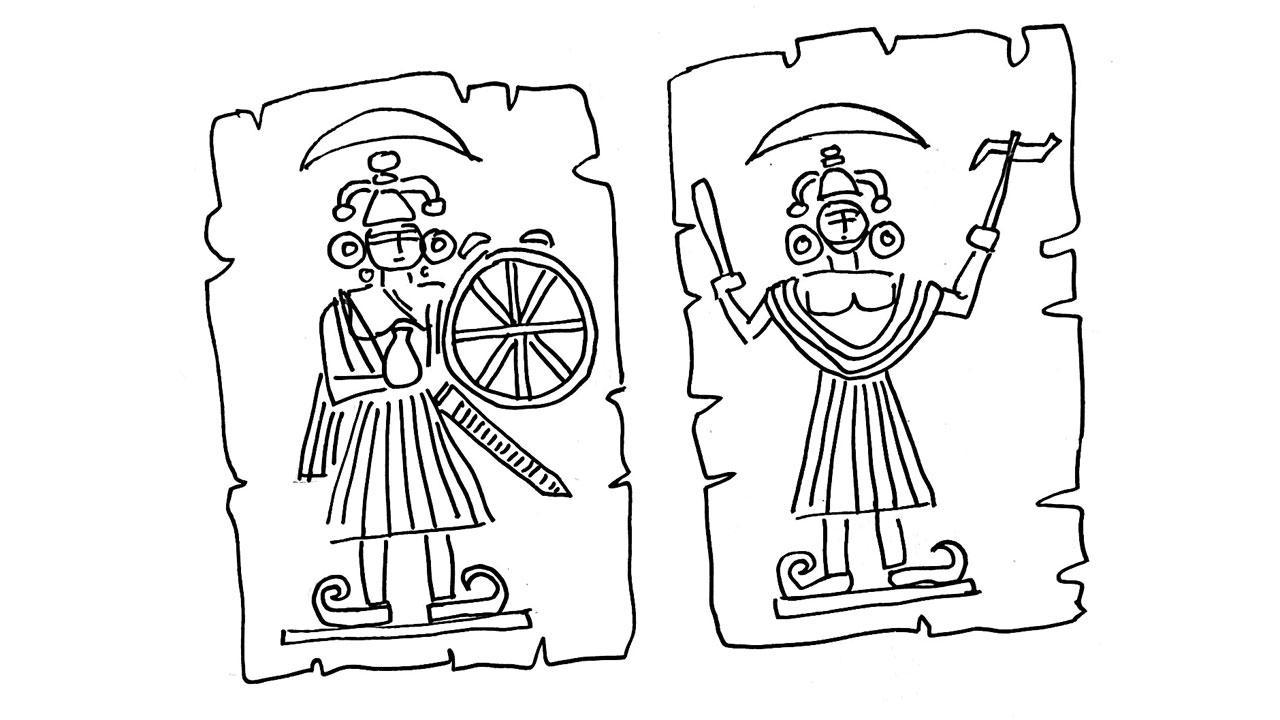An expensive shoe, phone or a bag, today does what rare gems and stones did two thousand years ago.

Illustration/Devdutt Pattanaik
 Demonetisation revealed to us the power of the state. The state tells us which piece of paper is money, and which is not. As humans, we can turn anything into money—and use it to trade. People have used everything from cowrie shells to coffee beans to bits of metal. It is all about trust. Does the buyer trust the value of the token being given to him by the seller? Today, we trust a number appearing on a screen as money. That is how much we trust technology.
Demonetisation revealed to us the power of the state. The state tells us which piece of paper is money, and which is not. As humans, we can turn anything into money—and use it to trade. People have used everything from cowrie shells to coffee beans to bits of metal. It is all about trust. Does the buyer trust the value of the token being given to him by the seller? Today, we trust a number appearing on a screen as money. That is how much we trust technology.
ADVERTISEMENT
That cowrie (from Maldives) was once trusted as currency is indicated by expressions like “phuti cowdy” (broken cowrie). In the old days, four broken cowries made up one cowrie. At one time women wore strings of cowrie to show their wealth; then they wore strings of gold coins; we cannot wear digital money. So, we display our wealth and status by wearing branded clothing, whose value is propagated through advertising and snobbery. An expensive shoe, phone or a bag, today does what rare gems and stones did two thousand years ago.
Coins, with clear symbols, appeared almost simultaneously 2500 years ago in Greece, India and China. In India, it was popularised by merchants of Ganga river valley. It was called karshapana, or kosha (treasury), that gives rise to the English word “cash”. In China, it had to deal with taxation and in Greece, it had to do with social mobility. This meant that employed people were not bound to a particular location by debt.
Coins were minted by the Indo-Greek kings, Kushan kings, Gupta Empire, who sought control of long-distance trade from the Gangetic plains, across the Hindukush, to Persia, Egypt and the Mediterranean. Symbols on coins were meant to evoke trust. Images of kings, images of local gods, images of guilds.
However, when the long-distance trading systems collapsed in India, around 500 AD, so did the popularity of coins. For local and small distance trade, nobody needed royal coins. While coins continued in North West India, amongst Pratiharas, they were not as popular in Pala and Rashtrakuta lands, which managed with cowries and metal ingots to balance the accounts.
But with the rise of the Islamic empires, coinage returned. Every sultan across the Islamic world needed to mint coins. It was absolutely critical. The appearance of the king’s name on the coin was key. He did not use his face, like earlier kings, as use of imagery was forbidden in Islam. But local Indians did not know how to read the script. They needed symbols of Hindu gods to trust a coin. So, the early Muslim kings used images of Hindu gods along with the Arabic script. A pragmatic approach. Old Islamic coins have images of Nandi and Lakshmi to gain the trust of the market forces. As the Islamic kingdoms became more and more powerful, this practice ceased. The tanka coins of the Khilji’s do not show any iconography and only the script. But during the Mughal era, things changed.
The great Mughals, such as Akbar and Jahangir, mingled with the local population and tried to establish an Indo-Islamic culture. They wanted to use local symbols in their coins. Therefore, we know that Akbar minted coins with the image of Ram on it. Jahangir used images from the Zodiac and even his own image, the Jahangiri coins, much to the horror of the orthodox Islamic lobby. Naturally, when Shah Jahan and Aurangzeb came to the throne with the help of the orthodox lobby, this practice stopped.
The author writes and lectures on the relevance of mythology in modern times. Reach him at devdutt.pattanaik@mid-day.com
 Subscribe today by clicking the link and stay updated with the latest news!" Click here!
Subscribe today by clicking the link and stay updated with the latest news!" Click here!












